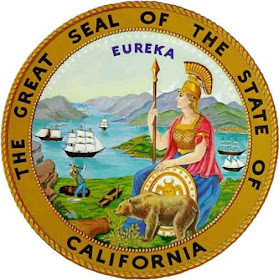CALIFORNIA CONSTITUTION
ARTICLE 1 DECLARATION OF RIGHTS
SECTION 1. All people are by nature free and independent and have inalienable rights. Among these are enjoying and defending life and liberty, acquiring, possessing, and protecting property, and pursuing and obtaining safety, happiness, and privacy.

And the Great Seal has a man in a funny hat with a pointed stick about to poke a hole in Eureka. One good earthquake and that thing is going right through Kmart at the south end of town.
ReplyDeleteFrom: http://www.netstate.com/states/symb/seals/ca_seal.htm
ReplyDeleteUnder the gaze of Minerva, the Roman goddess of wisdom, a miner works near the Sacramento River. A grizzly bear rests at her feet and ships ply the river. The Sierra Nevada mountains rise in the background. Wildlife, agriculture, natural beauty, commerce, and opportunity are all represented on California’s Great Seal.
The state motto, Eureka, sits over the mountains. A Greek word that means "I have found it," Eureka refers the discovery of gold in California. The miner, working with a pick, is another reference to the gold that was found in California. A pan and a rocker are also depicted on the seal near the miner. The pan was used to separate the gold from the dirt; just add water. The rocker is a larger and more sophisticated "pan." It allowed miners to process more dirt and sand faster. At the time the seal was designed, people were coming from all over the world looking to "strike it rich" in the gold fields.
Virtually all of the products coming in and out of California were carried over water routes at the time the seal was designed. Mining supplies, letters from home, luxuries, household items, and gold were all carried on ships. From the eastern United States, ships sailed south around Cape Horn and north to California. The ships, on a representation of the Sacramento River, symbolize the commercial greatness of California.
A sheaf of grain in the foreground represents California's agricultural wealth. In fact, many who came looking for gold found farming more profitable. Today, California is an agricultural giant among the states.
At the feet of Minerva, stands the California grizzly bear. A symbol of strength and independence, the grizzly bear is the Official State Animal and is the prominent feature on the California State Flag. Grizzly bears were, at one time, common in the state but the mass movement of people into California during the gold rush strained their habitat and caused their numbers to decline sharply. Today there are no wild grizzly bears left in California.
The seal was designed by Major R. S. Garnett of the U.S. Army, and adopted at the Constitutional Convention of 1849 before California became a state in June 1850. At the time of the seal's adoption, thirty states comprised the United States. Near the upper edge of the seal are 31 stars, anticipating California's admission. The original 1849 design is depicted to the right.
In 1937 minor changes were made to the seal.